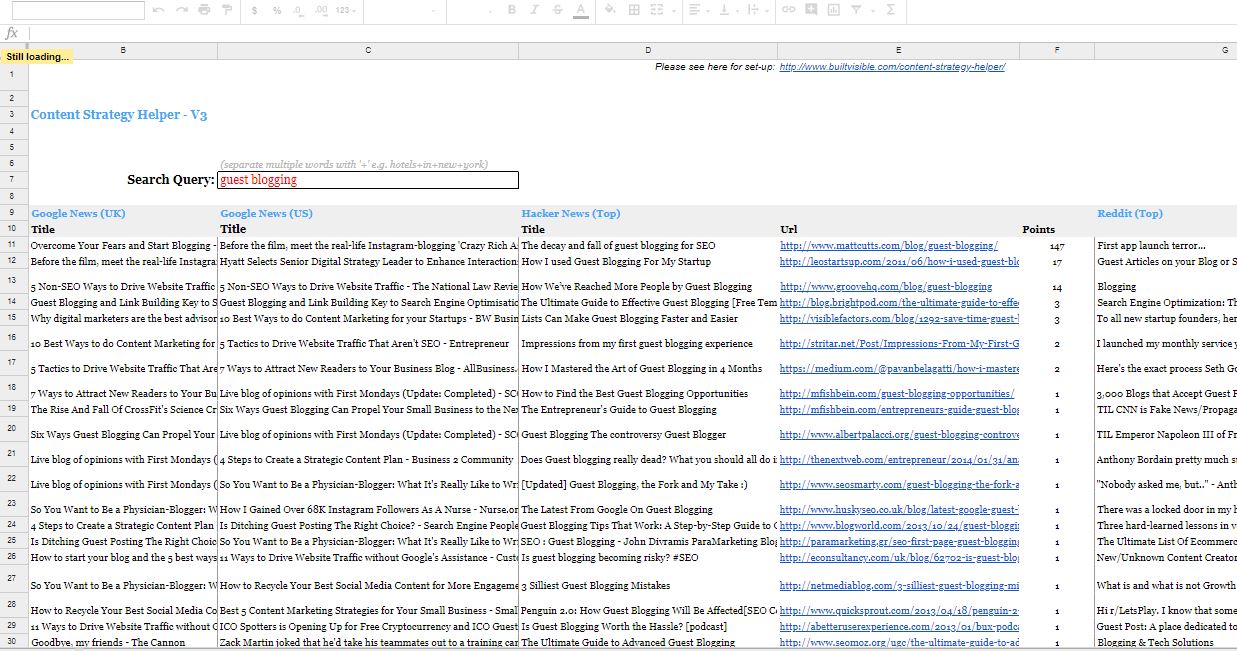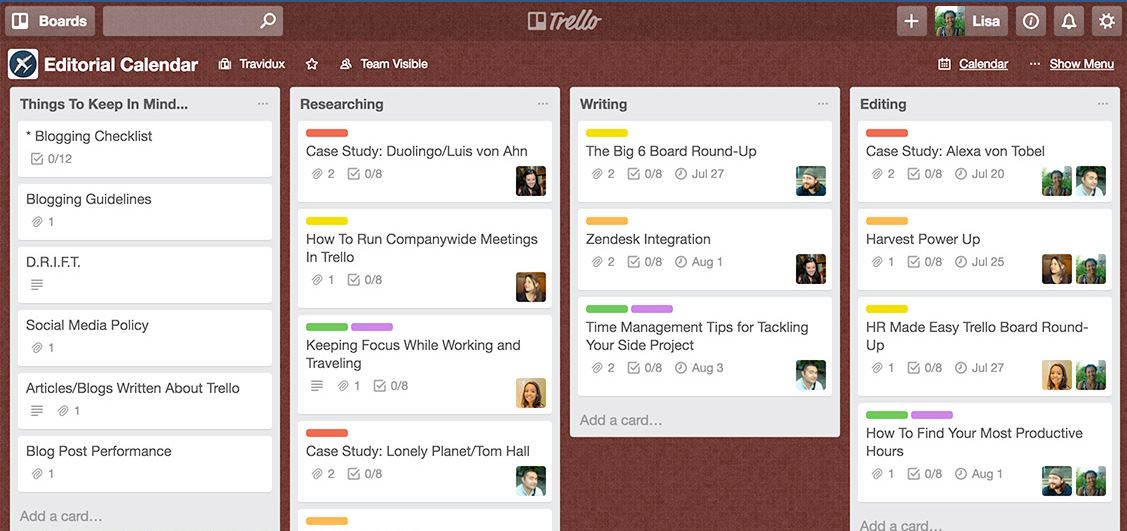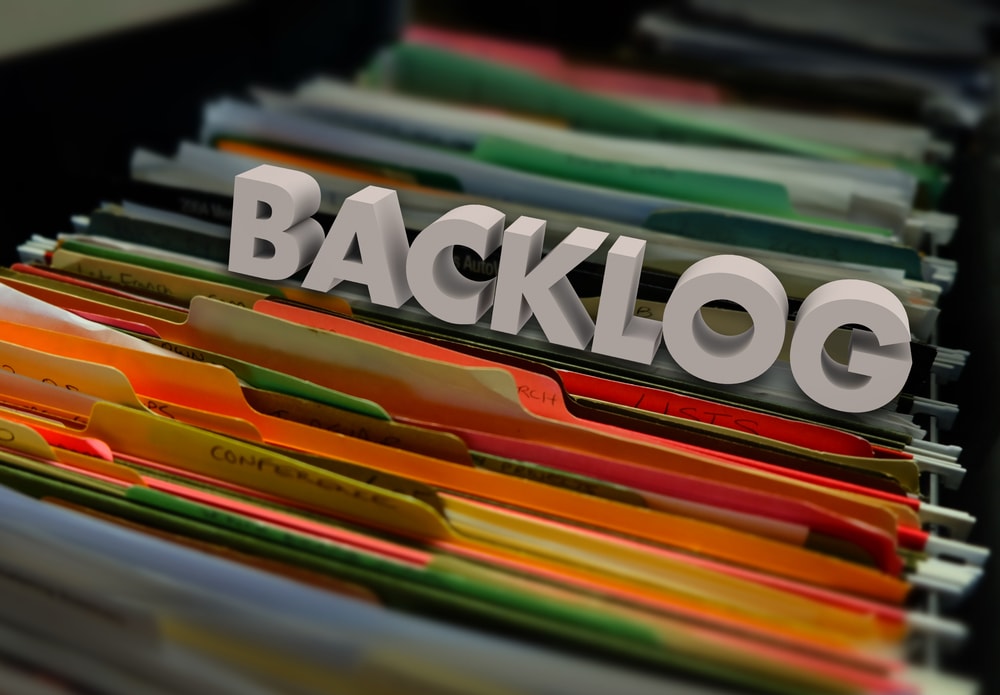There is a massive overall problem in the marketing industry with people who aren’t sure about how to create and sustain an long-term content strategy.
However, the last thing you want to do is start from scratch every week. It’s stressful, it’s unproductive, and it doesn’t help you create good content.
As part of your overall content strategy, you will need to know precisely when you want to publish your content on each platform you want to use. Also, you want to completely streamline how your content is produced.
In this article, we will go over how to build out a content calendar system by managing all of your content in just a few separate places.
Content Calendar Creation Tools
We will manage all of our content calendar materials in 3 places: Google Sheets, Google Calendar, and Trello.
Google Sheets

All of our article ideas will be stored in a Google sheet. This is where we will include notes and general references for creating our content.
Google Calendar
Here we will have our deadlines listed. This isn’t a mission critical part of the framework, but it does provide a helpful way to see your editorial calendar visually.
Trello

Trello is a great tool to keep your content organized and to collaborate as a team to develop your content together.
For instance, if you have an editor proofread your content, he or she can review the articles once you finish writing them.
You can create multiple stages for each article and keep them all organized without screwing up any other team member’s work. If you have articles that have a lot of discrete steps, such as research, writing, editing, and publishing, this tool can be a lifesaver.
Now it’s time to set up each piece one at a time.
Create a Backlog of Content

The first thing you want to do is make a list of all the content you could possibly write.
To do this, create a Google Sheet and fill it with your content ideas. There are a number of headings you want to create:
- Title
- Assigned Author
- Article Status
- Publication Date
- Project Rating
- Other Notes
The project rating will tell us, in a number rating from 1 (just an idea) to 3 (ready to be written and published). This gives us a feel for which articles we should start on first.
Write down as many ideas as you can think of. If you’re struggling to come up with ideas, focus on the desires of your buyer persona.
Next, go to the “Status” tab and mark all of your topics as ideas.
Then, look over your topics and see which ones are closest to being ready for publication in the rating system. For ideas that aren’t ready for prime time, include what you still need for each article idea in the “Other Notes” category.
Now you want to sort them by ranking number, from 3 to 1. Click the column marker above “Project Rating.” A small arrow will appear. Click on it. In the dropdown box select “Sort Sheet Z to A” This will place all article with a rating of 3 at the top.
Now that we have our article ideas in one placed and ranked in order of importance, now we need to schedule your content.
Set an Overarching Plan

Before we dive into the details of your content marketing strategy, you need to come up with a long-term plan. This will include the following:
Posting Frequency
You need to decide how often you’ll post your content.
Technically there is no magic number as to how many times you should post, but research from Writers Express has shown that companies that blog 16 times per month earn as much as 4.5 times as many leads as those who publishes content only four times in a month.
Again, there’s no magic number, but if you do have the time to post content more often, do it. Most importantly, you need to have a pace that you can maintain for weeks, months, and years of publishing content.
Different Topics
You do not want to post the same type of content constantly, just to change to a different type later on. Your editorial calendar should include a mix of subject areas to write about and share with your audience.
If you are having a tough time coming up with content ideas, one fantastic resource is Answer The Public. Just type a topic into the search box and you’ll get a list of questions people have searched for on Google relating to your search. Pick questions that seem relevant to your audience, decide on the content type, add a title to your calendar, and repeat until you have 4-6 weeks worth of content ideas.
Look at your articles over the span of a month. This time span should be long enough to provide lots of opportunities for content variety, but also be short enough to easily maintain.
You can use Google Calendar to look at the content you schedule ahead of time.
Be sure you cover more than one topic in a month. This is especially true if you are catering to multiple buyer personas. If you write about one particular topic for an entire month, then switch to another topic the next month, you’ll risk losing a huge chunk of your readership.
Again, post different types of content throughout the month.
Content Publishing
It can be difficult to provide consistent quality content week after week, but you can save a lot of time, energy, and stress if you don’t need to think of new content every time you sit down to write a post.
You will want a specific plan for each week. It won’t have to be formalized, but it should be well-known internally.
As an example, you could have a case study every other week, an infographic on the first week of each month, and a roundup of the week each Friday.
In the end it’s up to you, but a regular content schedule will make it far easier to prepare content in advance.
Format Variety
You do not want to base your entire content marketing strategy on one medium alone. You need to diversify with different types of content.
For example, if all you produce is long-form blog posts, you may be missing out on entire segments of your target audience.
According to Marketing Insider Group, as of 2017, 65% of senior marketers believe that visual content is core to their brand.
Also, video traffic is expected to represent 74% of all internet traffic this year, which is huge.
You may also want to consider interactive content. 75% of marketers who use it plan on increasing their use of that medium.
Your content marketing strategy can consist of any or all of these formats:
- Blogs
- Infographics and visuals
- Podcasts
- Videos
- Interactive content
Since they’re all consumed in different ways, you can maximize the appeal of your content and increase your traffic and conversions.
Document Your Plan
Once you have your plan, it’s time to make it official.
Open up Google Calendar and create a new event. Be sure to check the “Repeat” box and choose the recurrence depending on the event (weekly, monthly, custom, etc.)
Change the title to have “TBD” at the end and change it as you plan content.
This will allow you to see far in advance how your content schedule will look. It will also give you perspective on what deadlines are coming up and how long you have to meet them.
Schedule the Next 4-6 Weeks of Content

Now it’s time to figure out exactly when you’re going to publish each piece of content.
On Google Calendar you want to fill in the content pieces for the next 4-6 weeks. Having this schedule ahead of you lets you work seamlessly and reduce your stress if you usually write things the night before they’re due.
First, find all the articles in your Google Sheet that you ranked with a 3. These are the ideas that are complete and are ready to be written. Then you want to enter them into the spots in your calendar. replacing the “TBD” placeholder. Be sure that you change “Only this event.”
Using the context plan you created earlier, go in and individually change the dates for the next 4-6 weeks with the names of the content pieces you’ll be publishing.
In the Google Sheet, change the publication dates to match. If you have an author to take over writing your content, be sure to add his or her name in the “Author” slot as well.
Move Articles Into Production

It can be all too easy to let content pieces slip through the cracks, especially if you have multiple people working on a project.
You can help prevent this by creating a Trello account.
Step one for creating a Trello account for content will be to decide what stages each article will need to go through. What you may need is up to you, but these steps are recommended:
- Assigned to writer
- Ready for edits
- Ready for uploading and scheduling
This will let you get a 30,000-foot view of each and every article.
It’s also useful to see if an article is falling behind the scheduled time frame before it fails to meet the deadline.
As soon as you schedule content, you need to make a card for it on Trello. Assign a deadline to that card. Don’t make the deadline and the publication date the same.
If you’re just starting out with your queue, it would be a good idea to make it a week in advance, at least.
Eventually, you will want to build out a queue that is 4-6 weeks ahead of schedule, and your deadlines will also be 4-6 weeks before the actual publication date.
A critical piece of setting up Trello is assigning people to different projects. If you have multiple writers creating content for you, you need to include them in their respective articles. This also works if you add freelancers or ghostwriters to your team.
To keep things simple, have your writers create a Google Doc for each article and post the link to it in the description or comment of the article card. This will allow each teammate to access the article quickly and easily.
Build Your Queue
There are two recommended strategies for building your content queue.
1. Power through and write a ton of backlog content in the next few weeks.
This can be beneficial because it instantly puts you on the right path. You won’t have to worry about the hassle of adding new content later on.
The downside of this approach is finding the time to do all this writing. It may be difficult to postpone or cancel everything else on your to-do list.
Also writing a month or two of content in a compressed time frame will burn you out if you don’t have a team to support you.
2. Take the next 8-12 weeks and do a little extra as you go.
With this approach, your goal is to write 1½ pieces of content each week. This means that you’ll write the piece that needs to be published and make progress on the next piece. You’ll gradually build your queue with less stress.
The downside of this approach is you’ll need to wait a few months to get everything on track and ahead of schedule. If you only have a small team working with you, though, this is the better option.
Other Project Management Tools
You may prefer other tools to the ones we talked about earlier in this article. Here are some other project management tools that you can use to organize your content creation calendar.
CoSchedule
CoSchedule can help you build out a unified workflow for every project using a calendar interface. You can use it for collaborating with your team, turn your workflows into templates your entire team can use so projects run more smoothly, and check the progress of each individual team member on any given project.
Basecamp
Basecamp gives you a home screen that shows you a 10,000 foot view across your entire business. You get an “HQ” for communicating with your teams, dedicated spaces for each individual team, and private places to manage your company’s projects.
Airtable
Airtable uses what they call Blocks so you can fully customize your perfect workflow for your projects and your team. If you don’t want ot build an entire workflow from scratch, they also provide templates that you can use to hit the ground running.
Slack
Slack is more of a communication tool than a project management tool. It connects to other project management services such as Trello and Airtable so you can use their functionality without ever leaving Slack. You can communicate with your team and use these other tools inside Slack to help you stay connected with your team and respond in real-time to split-second situations that may arise at a moment’s notice.
Wrapping It Up
If you want to create compelling content on a regular basis, you need a great editorial calendar. Scheduling your content in advance is the only way to consistently produce in-depth, high-quality articles on a consistent basis.
Also, with a content calendar you can hire a freelancer and easily show them the when, where, how, and why of your projects to ensure everything still runs smoothly.
Now you know the tools and strategy that you need to build out a solid content calendar. Use the strategy laid out in this article, and you’ll finally be able to publish quality content with far less stress.
However, even with this information, it can still take a lot of time and energy to get everything in place for your content marketing strategy. Let us take that burden off of your shoulders so you can concentrate more on tasks that only you can do for your business.








Leave A Comment